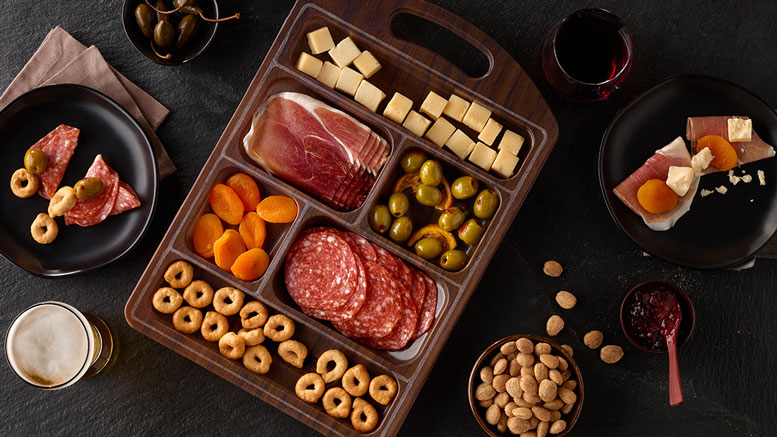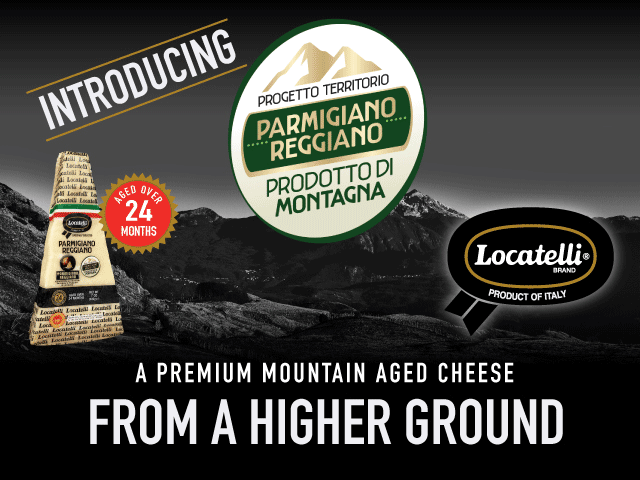Six Trends Poised to Boost Retail Deli Sales in 2025
January 14, 2025 | 9 min to read
Prepared foods and grab-and-go options are driving significant growth in the deli sector, with over half of deli sales attributed to these categories, which increased by 5.6% in dollars. Traditional items like cheese and meats are less dominant, with cheese at 17% and meats at 16%. As consumer trends shift toward fresh and convenient meals, Shane Ward from Columbus Craft Meats emphasizes the need for evolving technology and merchandising strategies in the deli.

Prepared foods, grab-and-go see growth in the deli.
Most Americans eat two (31%) or three (64%) meals daily, plus two (23%) to three (22%) snacks, based on a review of the 2020 Dietary Guidelines Advisory Committee Report. This is the total share of stomachs up for grabs by retailers and restaurants.
Major trends for 2025 are poised to give retailers, especially the retail supermarket deli, a chance at a bigger bite. This is especially true considering how the guard has changed, offerings-wise, in the deli over the last decade-plus.
Traditional mainstay categories, such as cheeses and meats have taken a back seat in sales to prepared foods and meals, which represent over half (55.8%, +5.6% in dollars) of deli sales, according to 52-week data ending Oct. 6, 2024, by Circana OmniMarket Integrated Fresh, a Chicago-based market research firm. The cheese category is second (17%, +1.4%) and meats third (16%, -4.3%), with deli entertaining fourth at 11.2%, +5.1%
“The deli will lead in this space as consumer trends shift toward fresh, prepared and grab-and-go. It will be more than just products — technology, in-store communications, and merchandising will all continue to evolve,” says Shane Ward, assistant director of marketing for Columbus Craft Meats, in San Francisco, CA.

Here are six top trends for 2025 and how they can help the deli grab a bigger share of stomach.
1. EATING & ENTERTAINING STAY HOME
First driven back into the kitchen by the pandemic, and most recently by economic strains, consumers continue to cook at home, says Heather Prach, vice president of education and industry relations for the International Dairy Deli Bakery Association (IDDBA) in Madison, WI. “Shoppers are making 78% of their meals at home, and 21% of shoppers say they have not purchased from a restaurant in the past few weeks.”
Fifty-four percent of shoppers say they are preparing more hybrid meals at home, according to the Power of Foodservice at Retail 2024 report by FMI — The Food Industry Association, in Arlington, VA. “This includes some scratch and some semi- and fully prepared items,” says Rick Stein, FMI vice president of fresh foods.
Ingredient starters are a significant trend affecting the supermarket segment, says Megan Ward, senior brand manager for retail sales at Hormel Foods in Austin, MN. “Consumers are looking for quality shortcuts to assist in meal prep. Examples include pulled chicken, turkey, pork and beef — all items in our portfolio today.”
Shopper “meal fatigue,” which drew a lot of focus during the pandemic, remains a challenge, with one-third of customers asking for additional help with meal planning, according to FMI’s Power of Foodservice at Retail 2024 report.
“Supermarkets can pursue a range of strategies to be supportive. These include meal bundles, in-store displays that combine ingredients for a meal, and more heat-and-eat choices. These strategies can play out both in-store and online. A carefully placed QR code can help shoppers dive deeper and offer meal planning and preparation support,” says Stein.
Fifty percent of shoppers report they had plans to entertain at home this past summer, according to Circana, as shared by Columbus Craft Meats’ Ward. “Entertaining has changed to smaller gatherings in this post-COVID environment. The deli is a key area in which to meet these consumers’ needs. Our tasting boards are the perfect solution for those not only looking to entertain and impress, but who are also tight for time or looking for help to find their perfect pairings.”
2. THE DSR (DELI SERVICE RESTAURANT) CONCEPT RISES
Some retailers have added full restaurants in-store. For example, Wegmans Food Markets, a 111-store chain based in Gates, NY, offers its Market Café, Next Door by Wegmans, Amore Italian Restaurant and Bar, and the Burger Bar by Wegmans at select locations.
“Whether it’s your favorite chain Italian restaurant or the local Indian restaurant down the street, we anticipate seeing beloved restaurant brands being brought to the deli aisle,” says Hormel Foods’ Ward.
Beyond this, many retailers and manufacturers recognized an opportunity to fill the void when the foodservice industry shut down during the pandemic.
“As a result, we’ve seen great innovation in this space among the forward-thinking retailers, which have upped their game with more sophisticated prepared foods,” says Maeve Webster, president of Menu Matters, in Arlington, VT.
“The flavors, formats, and inspirations are more current and lean a bit less on the most traditional comfort foods, which have largely driven prepared food options. Additionally, consumers are increasingly looking for restaurant-style or restaurant-level meals outside restaurants,” she says.
Examples are online menus, advance ordering through apps, and pick-up options, all conveniences shoppers are accustomed to at restaurants.
“Food retailers who take some of the technology and convenience solutions from the restaurant playbook have an opportunity to differentiate themselves,” says Stein.
TV screens are also becoming more common in the prepared foods department, adds Wade Hanson, senior principal for advisory practice at Technomic, Inc., in Chicago, IL. “We have been visiting grocery stores nationwide for a supermarket foodservice channel assessment and have seen more screens than ever before. From Kroger to Winn-Dixie, from Amazon Fresh to Hy-Vee, you’ll see screens that display fairly extensive product descriptions and customization options.”
The supermarket-prepared segment will continue to grow for two reasons, says Stephen Davis, research and insights manager and author of Chicago, IL’s Datassential’s 2024 Supermarket Segment Guide. “It works well for consumers who want to trade down and away from higher-priced restaurant meals, and also for those who may want to trade up and buy something prepared rather than cook for themselves at home.”
3. RESTAURANT-STYLE RX FOR THE DELI MENU
There is plenty of room for innovation in deli-prepared foods, says Mike Kostyo, vice president of Menu Matters. “Trends in flavors and ingredients like Asian barbecue, ultra-spicy options, sweet-and-spicy options, more Mexican proteins and cheeses, relentless innovation in chicken and chicken sandwiches, more drink innovation around options like boba and dirty sodas, etc. can all make a bigger impact in delis and prepared foods.”
Offering a rotating selection of international specialties can turn the deli into a culinary destination, says Sharon Olson, executive director of Culinary Visions, a division of Olson Communications, Inc., Chicago, IL. “The Les Dames d’Escoffier International (LDEI) Trends Survey identified exploring the world through food and the demand for dishes that are intentional mashups of disparate cuisines as finding favor with consumers. This attracts adventurous food enthusiasts and provides a unique experience that sets the business apart from competitors.”
Some of the newest items from the George DeLallo Company, Inc., offer big, bold flavors, says Giuliana Pozzuto, marketing director of the Mount Pleasant, PA, company. “We are satisfying consumers’ desires for value-added olive and antipasti salads by offering diverse flavor combinations reminiscent of restaurant appetizers. Our latest salad is made by pairing goat cheese with pitted olives, peppers, and cornichons, and another combines the trending spicy Calabrian chile and sweet orange peel marinade that makes the olives pop and gives olive consumers a whole new flavor profile to enjoy.”
Innovation will also come to the deli in 2025 with new additions.
“Many supermarkets are de-emphasizing the hot bar and hot foods’ specialty stations. Labor costs are one reason it has become difficult for prepared foods departments to execute hot bars, barbecue stations, pizza ovens, etc. On the other hand, we’re seeing more snack foods (for morning snacks, afternoon snacks, and late night), and we are seeing more beverage offerings, including teas, juices and smoothies,” says Technomic’s Hanson.
The next frontier in the retail deli is breakfast. Morning meal sales totaled only 1.2% of prepared foods and meals sales, based on Circana statistics, but there was double-digit growth at 19.7%.
“Take the dollar from the local donut and bagel shops by offering a bagel and cream cheese program in-store,” says Carl Cappelli, senior vice president of sales and business development for Don’s Prepared Foods, in Schwenksville, PA.
“We offer 15 flavors of cream cheese, from savory to sweet. Delis can create a Bagel Meal Kit Box with six bagels on each side and four flavors of cream cheese in the middle.”
4. ‘CLEAN’ IS DOUBLY IMPORTANT
Operators and manufacturers must be aware of issues that may impact consumer purchasing in the deli, according to Menu Matters’ Kostyo. “Based on Menu Matters’ 2024 Consumer Need States Report, there are health concerns, with 66% of consumers telling us they think ultra-processed foods are unsafe to eat, while 44% specifically called out processed meats and deli meats as unsafe. The same percentage, 44%, have also said they have noticed more food recalls in recent years. Manufacturers need to tackle these challenges.”
Indeed, deli meat category sales fell 4.3% based on 52-week Circana data ending Oct. 6, 2024. Service lunch meat took the biggest hit at -6.9%, with grab-and-go lunch meat down 2.9% in dollars. Presliced lunch meat was up 1.6% in sales, likely banking on shoppers’ desire for convenience.

“To replace lost sales, operators are focusing on other parts of the deli like the soup category,” says Bob Sewall, vice president of sales and marketing at Fall River, MA-headquartered Blount Fine Foods, which makes wholesale frozen and fresh soups under the Blount and Panera Bread brands. “Soups have a health halo around them, and our ingredient statements are some of the cleanest on the shelf. We also offer many soups, including all-natural, organic, wheat-free, vegan, vegetarian, dairy-free and low-fat.”
The LDEI Trends Survey identified seasonal plant-forward eating as one of the significant factors affecting consumer food purchases.
“Embracing plant-based trends broadens the customer base and aligns deli businesses with health-conscious consumers. By incorporating creative and flavorful plant-based options, delis can attract dedicated vegans and curious omnivores looking to explore new culinary experiences,” says Culinary Visions’ Olson.
In October, Hodo, an Oakland, CA-based artisan tofu and plant-based food company, introduced its new Saucy Tofu in three trending flavors: Thai Red Curry, Japanese Teriyaki and Korean BBQ. Each 16-ounce pack comes with pre-cut tofu and two sauce packets, is ready to heat and eat in 5 minutes, and is ideally cross-merchandised with basket-building grains, noodles, and/or veggies.
“We see the future of retail delis as offering more minimally processed plant protein options, such as tofu, as more omnivorous consumers seek to reduce animal protein and add more plant protein to their diets,” says Minh Tsai, Hodo’s founder and chief executive officer.
Clean also means food is safe.
Foodborne illness prevention and attention to sanitation are set to increase, says Pam Loupe, director of marketing for Best Sanitizers, in Penn Valley, CA. “With consumers expecting higher safety standards and regulators enforcing stricter controls, delis will need highly effective sanitization solutions.”
The company’s Alpet D2 hand sanitizers are highly effective against pathogens like listeria, salmonella and E. coli.
5. VALUE IS RE-DEFINED
Seventy-two percent of consumers agree the economy directly impacts their grocery spending habits, according to the October 2024 released The 2024 State of Spend, by the Ibotta Performance Network, in Denver, CO.
“We’ve seen many consumers selecting the lower-cost options, the private label brands, etc. Some 29% of consumers told us they buy more private label goods now,” says Menu Matters’ Kostyo, citing the company’s 2024 Consumer Need States Report.
“Artisan cheeses continue to be in demand,” says Frank Alfaro, vice president of food service sales at BelGioioso Cheese, Inc., in Green Bay, WI. “There are flavor factors you can’t get without high-quality ingredients like 100% milk and allowing cheese to age properly. For example, our American Grana is a premium Parmesan that matures at least 18 months on wood shelves in our special caves.”
6. FAST FASTER, SLOW SLOWER
Consumers want efficiency in the purchase process, such as online shopping, self-checkout and automation. In-store display tactics like cross-merchandising and cross-promotions for meal solutions, competitive pricing for cost efficiencies, and secondary display placement and technology to drive impulse purchases are all examples of helping consumers shop the deli in the fast lane.
They are also interested in experiential engagement through premiumization, memory creation, and education-driving confidence in their investment. Displays utilizing technology to drive consumers to recipes, education, games, and social media platforms can achieve this. In-store demos and flagship store environments help draw consumers into an immersive experience, according to Hormel Foods’ Ward.
“We achieve ‘fast’ selling by making our packaged goods as visible and accessible as possible at retail via custom branded displays. ‘Food Forward’ experiences are ‘slow’ impactful selling,” says Ward. “The same shopper finds both fast and slow appealing.”
38 of 82 article in DeliBusiness Winter 2024-2025

